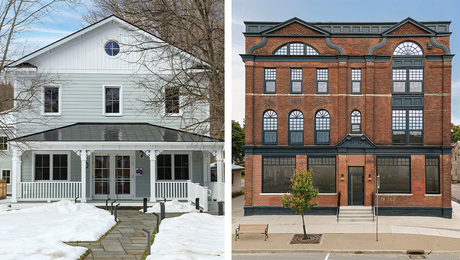Big news in tablesaw safety
Last year, I wrote the article Avoiding Accidents on the Tablesaw (FHB #180, pp.86-91). In it, I stressed how dangerous a portable tablesaw can be, especially because so many carpenters remove the blade guards. Guard design on portable tablesaws has always been problematic: The plastic covers quickly become obscured by scratches and sawdust, so you can’t see through them; the guard interferes with the fence when ripping narrow pieces; and for rabbets, you have to remove the guard completely. On many saws, removing the guard is such a pain that, once removed, guards are rarely seen again.
In my article, I described how I converted the splitter on my saw into a riving knife, which helps to prevent kickback. Although this modification meant I could no longer use the blade cover and antikickback pawls, I argued that “the protection of a riving knife that is always in place outweighs the protection of a blade cover that I invariably remove and forget (or don’t bother) to reinstall.” Now the situation has changed, and as a proponent of job-site safety, I couldn’t be happier.
In response to a growing need for improved tablesaw safety (and perhaps in response to the success of SawStop’s revolutionary safety system), tool manufacturers—including Bosch, DeWalt, Makita, and Porter-Cable—have actually worked together to develop a better guard system for portable tablesaws. Of course, each manufacturer has incorporated its own tweaks, but from what I’ve learned so far, the guards will all be similar. In fact, the DeWalt (available next year) and the Bosch (released in July) are nearly identical.
I’ve been testing the new Bosch portable tablesaw in my shop, and I’m impressed (you’ll find a review on my Web site, www.garymkatz.com). The new blade-cover design includes a two-piece aluminum guard that lets you see through the guard to the blade and the measurement mark. The new splitter is convertible to a riving knife. In seconds, the antikickback pawls and cover can be removed from the splitter and the splitter lowered beneath the top of the blade. The entire guard system is literally a snap to remove and replace, and it can be stored onboard when not in use. This is one guard that carpenters won’t be throwing away. I commend these companies for overcoming brand rivalry and working together to solve a problem that affects us all.
—Gary M. Katz, Reseda, Calif.
Egress windows can be smaller
I would like to clarify one point in your article A Basement Bedroom Demands an Egress Window (FHB #189, pp. 86-91). On p. 87, it states that windows require a net-clear opening of 5.7 sq. ft. Generally, that is true. However, Section R310.1.1 of the 2006 International Residential Code contains an exception that states, “Grade-floor openings shall have a minimum net-clear opening of 5 sq. ft.”
A grade-floor window is defined in Chapter 2 of the IRC as “a window or other opening located such that the sill height of the opening is not more than 44 in. above or below the finished ground level adjacent to the opening.” Depending on the grade adjacent to the basement wall, the basement windowsill can be less than 44 in. from the adjacent grade, which would allow the installation of a slightly smaller emergency and escape window.
—Andrew S. Bowman, Lancaster, Pa.
Lighting design that meets California’s code
Although Nancy McCoy lives in Marin County (Personalizing an Everyday Ranch, FHB #189, pp. 74-79), she does not comply with the California energy code (Title 24), which requires 50% of the kitchen wattage to be from highefficiency (fluorescent or LED) sources. However, in her answer to the lighting question on p. 98 of the same issue, Nancy covers the requirement. There are many good ways to comply: fluorescent tubes above and below the cabinets, cove lighting with fluorescent tubes, recessed fluorescent lights (in many styles), skylights with fluorescent tubes integrated into the lightwell, etc.
—Judith Wasserman, Palo Alto, Calif.
Author Nancy McCoy replies: Our project was started before the October 2005 update to California’s Title 24 energy code. Under the old code, we were not required to have 50% of the wattage be fluorescent. But our center fixture is available by custom order in a fluorescent lamp (www.lightspann.com). As a lighting designer in California, I am aware of the new requirements and work with homeowners and designers to meet the requirements. In fact, my husband and I developed an online tool to help designers comply with Title 24. At our Web site, www.so-sonoma.com, you can select a palette of colors and materials under four different fluorescent sources to make residential kitchens and other “green” spaces look good.
Debating deck details
I was glad to see the deck article in your June/July issue (Custom Details Make a Better Deck, FHB #188, pp. 46-51), but as a deck builder in the great Northwest, I have a couple of concerns. On p. 47, you show a drawing with pressuretreated 2×6 blocking laid flat to carry the decking ends. I’m sorry, but that is just wrong. The block will sag over time; an additional joist should have been used. Also, while the arbor/pergola looks great, it appears to be built of fir. If anyone in the Northwest tries this, they will end up with a big pile of rotten wood in about two years. Fir may be OK in Montana, but here in Rainytown USA, cedar is preferred. Sorry to be a pain, but people need to know that there are correct and incorrect ways to build.
—David J. Gardenhire, Black Diamond, Wash.
Author Michael Ayers replies: Thank you for your concern about the detail of blocking on p. 47. Although not shown in the drawing, the flat 2×6 is supported with blocks nailed between the joists every 2 ft. or so. As for lumber choice, I agree that in a wetter climate, cedar or redwood is a better choice for a pergola. Even in Montana, fir is not my favorite choice. However, it is an economical one. And when treated and maintained with a full-body stain, as in this case, the fir has well over a 20-year life span.
Bad practice does not make perfect
Let me start by saying how much I enjoy Fine Homebuilding; you can dismiss all of your critics. Keep up the fine work.
Daniel S. Morrison’s article in the August/September issue regarding the Oregon legislature’s proposal to regulate persons involved with building envelopes caught my eye (FHB #189, “Cross Section,” p. 24). I think Dan’s photo of bad building practices pales in comparison to the one I took at my own house. I have replaced all the windows in the 20-year-old building, and all rough openings showed evidence of water intrusion. I had to remove the ledger board on my deck so that I could strip off the siding and sheathing to remove rot under the slider because of the shoddy workmanship that had been done.
I deplore the thought of more regulations because it becomes a burden on those who are competent and have good intentions. Unfortunately, the building industry in too many instances has become a haven for the incompetent and dishonest. I feel bad for those who have to fight this stigma in order to make an honest living as well as for those who are victimized by any deception.
—Larry Gould, Wilmington, Mass.
Let market forces drive energy efficiency
In his essay Our myopic building codes (Houses, FHB #187, pp.10-16), David Eisenberg’s environmental goals are worthy, but his methods are a prescription for longer review periods, longer build times, more-expensive homes, and fewer property rights, all without affecting the problem of global pollution.
As petroleum-based energy increases in cost, market forces will continue to drive people to increased energy efficiency. Adding additional layers of review to plans and proscribing that “best plans” be reviewed first is a recipe for more costs, another unnecessary governmental layer, and further manipulation of the review process to suit every inspector’s idiosyncrasies. If we really look at energy consumption globally, we find that every barrel of oil we save here is a barrel of oil that China or India can and will buy cheaper and burn dirtier. The best, cheapest, fastest method to achieve greater energy efficiency is a carbon tax. It gets everyone on board (though to be truly effective, it would have to be a global carbon tax).
This is not to say various agencies or groups should not promote increased passive design, downsizing, or any other potentially worthwhile building detail. The problem arises not from advocating but from mandating. Directives that come from a narrowly focused group, well intentioned as they might be, ignore market forces, reduce individual choice, and ultimately provide less for fewer people.
—David M. Bekus, Skillman, N.J.
Author David Eisenberg replies: Your arguments in favor of market forces driving beneficial outcomes are not new, nor are they proving to be accurate in the cities such as Seattle, Chicago, or Aspen, where the concepts I wrote about have been embraced by local government. I didn’t suggest adding layers of review or mandating that best plans be taken first. There is a conceptual leap between my point that the current process often penalizes those trying to achieve leading-edge efficiency and environmental performance while rewarding those who build at the lowest possible level, and your suggestion that having building departments become community resources for the best building rather than seeing themselves mainly as building police patrolling the bottom would add layers of review, time, and expense to the process for everyone else.
As a former contractor and two-term member of the board of directors of the U.S. Green Building Council (www.usgbc.org), I have long been engaged in market transformation as a vehicle for change.
But I have also spent 15 years educating people about the energy, climate, and environmental issues that are finally making it into mainstream consciousness while watching “the market” vigorously thwart this awareness. When market forces account for the well-being of future generations and demonstrate accountability for those without a voice or a large economic stake, I’ll be much more inclined to think that market forces by themselves can lead us in a sustainable direction. The price of energy alone can’t drive all that must be done to address climate change and other serious impacts of the built environment.
While I agree about the desirability of a carbon tax or some other mechanism to internalize the enormous societal and environmental costs of current practices, effective strategies to drive such changes will need to rely on both regulation and incentives.
As for China and India, the most powerful influence we can have on them is to lead by demonstrating the best that can be achieved, not the least.
Cork flooring fades in sunlight
I immediately noticed the floor in Michael De Biasse’s kitchen remodel (A New Kitchen and a Better Backyard, FHB #188, pp. 69-73). I also used cork flooring of a similar color in a remodeling project in 2002. Within the first year, I began to notice that the floor color was fading significantly in the areas that receive natural light. This problem is most noticeable with the darker tiles containing more pigment.
I expressed my concerns to the manufacturer and was told that cork was a natural product, and that fading is natural. Although I’m disappointed that the flooring has faded, I still believe in the product. But manufacturers should be more up front about the fading issue. However, if anyone knows of a solution other than restricting the natural light, I would like to hear about it.
—Nick Cindrich, Apex, N.C.
Fine Homebuilding Recommended Products
Fine Homebuilding receives a commission for items purchased through links on this site, including Amazon Associates and other affiliate advertising programs.

Affordable IR Camera

Reliable Crimp Connectors

8067 All-Weather Flashing Tape






















